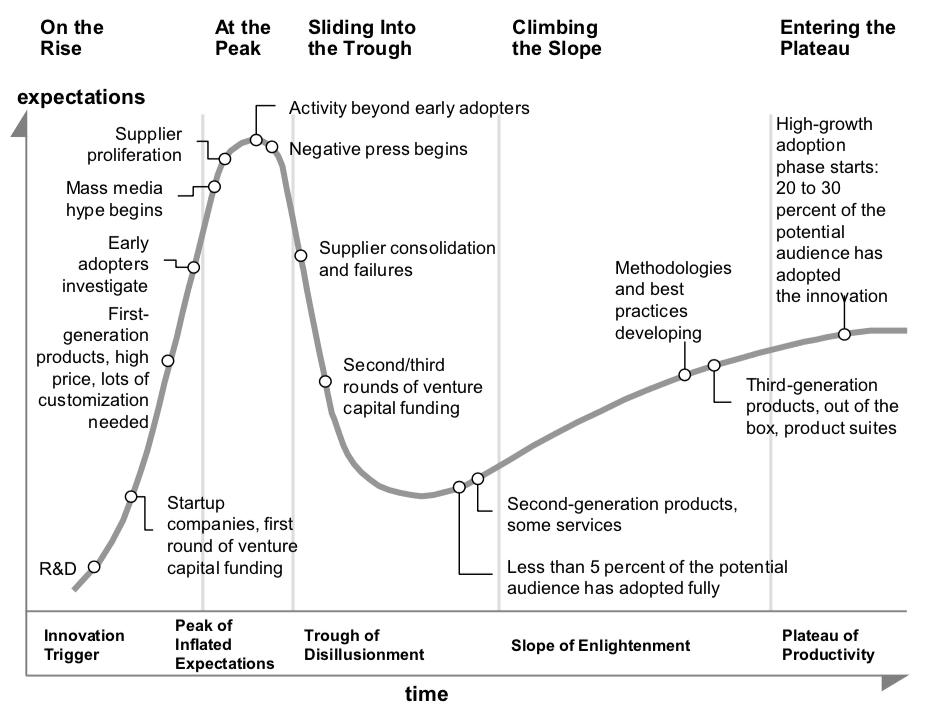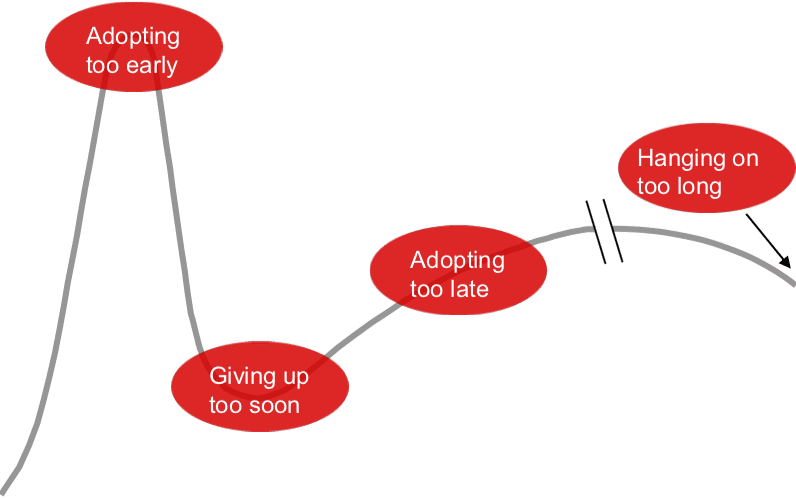What is the Hype Cycle and how use it at our advantages
The "Hype Cycle" is a concept developed by the research and advisory firm Gartner, which provides insights and analysis for various technology-related trends. It is a graphical representation that illustrates the maturity, adoption, and business impact of emerging technologies or innovations over time.
The Hype Cycle consists of five main phases:
Technology Trigger: This is the starting point of the cycle, representing the emergence of a new technology or innovation. It may be in the form of a breakthrough, a new concept, or a prototype that captures the attention of early adopters and the media.
Peak of Inflated Expectations: In this phase, the technology receives significant attention, and there is often an overestimation of its potential benefits. It is a period of "hype" where expectations are at their highest, and there is a lot of excitement and media coverage around the technology.
Trough of Disillusionment: As the initial hype subsides, the limitations and challenges of the technology become apparent. This phase is characterized by a dip in interest and disillusionment among some early adopters who may not see the expected results or face difficulties in implementation.
Slope of Enlightenment: During this phase, more practical and successful implementations of technology start to emerge. Lessons are learned from the initial failures, and the understanding of the technology's potential benefits becomes more realistic.
Plateau of Productivity: In this final phase, the technology reaches a point where its benefits are well understood and widely accepted. It becomes more stable, mainstream, and integrated into various industries or domains, leading to widespread adoption and practical applications.
The Technology Trigger
"Technology Trigger" is the first phase of the Hype Cycle.
It represents the initial emergence or recognition of a new technology, innovation, or trend that has the potential to create a significant impact and disrupt existing markets or industries.
During the Technology Trigger phase, the technology is often in its early stages of development and may not yet be fully functional or widely adopted. It could be a new scientific discovery, a breakthrough in research and development, a new product concept, or a novel approach to solving a problem. At this stage, the technology has captured the attention of early adopters, technologists, researchers, and innovators who recognize its potential and possibilities.
Key characteristics of the Technology Trigger phase include:
Novelty: The technology is a new and unique concept that has not been widely seen or used before.
Proof of Concept: There might be early prototypes, experiments, or research papers demonstrating the feasibility and potential of the technology.
Media Attention: The technology receives attention from specialized media outlets, research institutions, and technology enthusiasts, generating buzz and interest in the field.
Early Adopters: Early adopters and visionaries begin exploring and experimenting with the technology to understand its capabilities and potential applications.
Uncertainty: There is a level of uncertainty surrounding the technology's commercial viability, scalability, and broader impact.
Potential Disruption: The technology has the potential to disrupt existing industries, markets, or ways of doing things, though the extent of its impact is not yet clear.
The Technology Trigger phase sets the stage for the Hype Cycle, leading to the subsequent phases of the Peak of Inflated Expectations, Trough of Disillusionment, Slope of Enlightenment, and Plateau of Productivity. As the technology progresses through these phases, it gains a more comprehensive understanding of its strengths and limitations, ultimately determining whether it becomes a mainstream solution or fades away over time.
Inflated Expectations?
Blockchain Technology: Blockchain technology, known primarily for its association with cryptocurrencies like Bitcoin, emerged as a Technology Trigger. It was a novel approach to secure, decentralized, and transparent record-keeping. As it progressed through the Hype Cycle, it went through significant media attention, inflated expectations, and then faced challenges regarding scalability and real-world implementation. However, blockchain has since found practical applications in various industries beyond cryptocurrencies, such as supply chain management, healthcare, and finance.
Virtual Reality (VR): VR technology was a Technology Trigger when it first emerged, offering immersive and interactive experiences in computer-generated environments. It captured the imagination of many early adopters, but the initial iterations were expensive and had limited content. Over time, the technology has advanced, and VR has found applications in gaming, training, education, and entertainment.
Internet of Things (IoT): IoT, which refers to the interconnectivity of various devices and objects through the internet, started as a Technology Trigger. It promised a world where everyday objects could communicate and share data to improve efficiency and convenience. While the IoT has made significant progress, it also faced challenges related to security, standardization, and interoperability. As these issues are addressed, the IoT continues to grow in various industries, including smart home devices, industrial automation, and healthcare.
Artificial Intelligence (AI): AI has been through multiple cycles of hype and disillusionment over the decades. It started as a Technology Trigger and has seen tremendous growth due to advancements in machine learning, natural language processing, and computer vision. AI is now widely applied in areas like virtual assistants, recommendation systems, autonomous vehicles, and healthcare diagnostics.
Autonomous Vehicles: The concept of self-driving cars and autonomous vehicles sparked as a Technology Trigger, capturing attention from automakers, tech companies, and the general public. As the technology progressed, there was initial excitement about the potential for safer and more efficient transportation. However, challenges related to regulations, safety concerns, and ethical considerations brought it through the Trough of Disillusionment. Despite the challenges, significant progress continues, and autonomous vehicles are gradually being integrated into transportation systems.
The MainStream Adoption
Mainstream adoption is where technology or innovation has achieved widespread acceptance and integration into various industries, markets, or society as a whole. During this phase, the technology becomes a standard or common practice, and its use is no longer limited to early adopters or specialized niche markets.
Key characteristics of mainstream adoption include:
Market Penetration: The technology has reached a critical mass of users or customers, and its adoption has expanded beyond the initial early adopters. It is being used by a significant portion of the target market or the general population.
Stable and Mature: The technology has gone through its initial challenges, and most of the major issues have been resolved. It is considered mature and stable, with a well-established ecosystem of products, services, and supporting infrastructure.
Integration and Compatibility: The technology is seamlessly integrated into existing systems, processes, and workflows. Interoperability and compatibility with other technologies are generally well-established.
Lower Costs and Wider Availability: As mainstream adoption progresses, economies of scale typically lead to lower costs for the technology and its related products or services. This increased availability and affordability contribute to its wider adoption.
Standardization and Regulations: Standards and industry regulations may have been established to ensure consistency, safety, and interoperability across different implementations and vendors.
General Awareness: The general public is aware of the technology and its benefits, and there is a broad understanding of how it can be utilized to address various needs and challenges.
Shift in Focus: Innovation and attention start to shift towards the next emerging technologies or improvements on the existing one, as the focus is no longer primarily on the adoption itself but on optimizing and enhancing the technology's capabilities and applications.
Examples of technologies that have achieved mainstream adoption include smartphones, the internet, social media platforms, and cloud computing. Once a technology reaches this stage, it becomes an integral part of daily life, business operations, and society as a whole.




